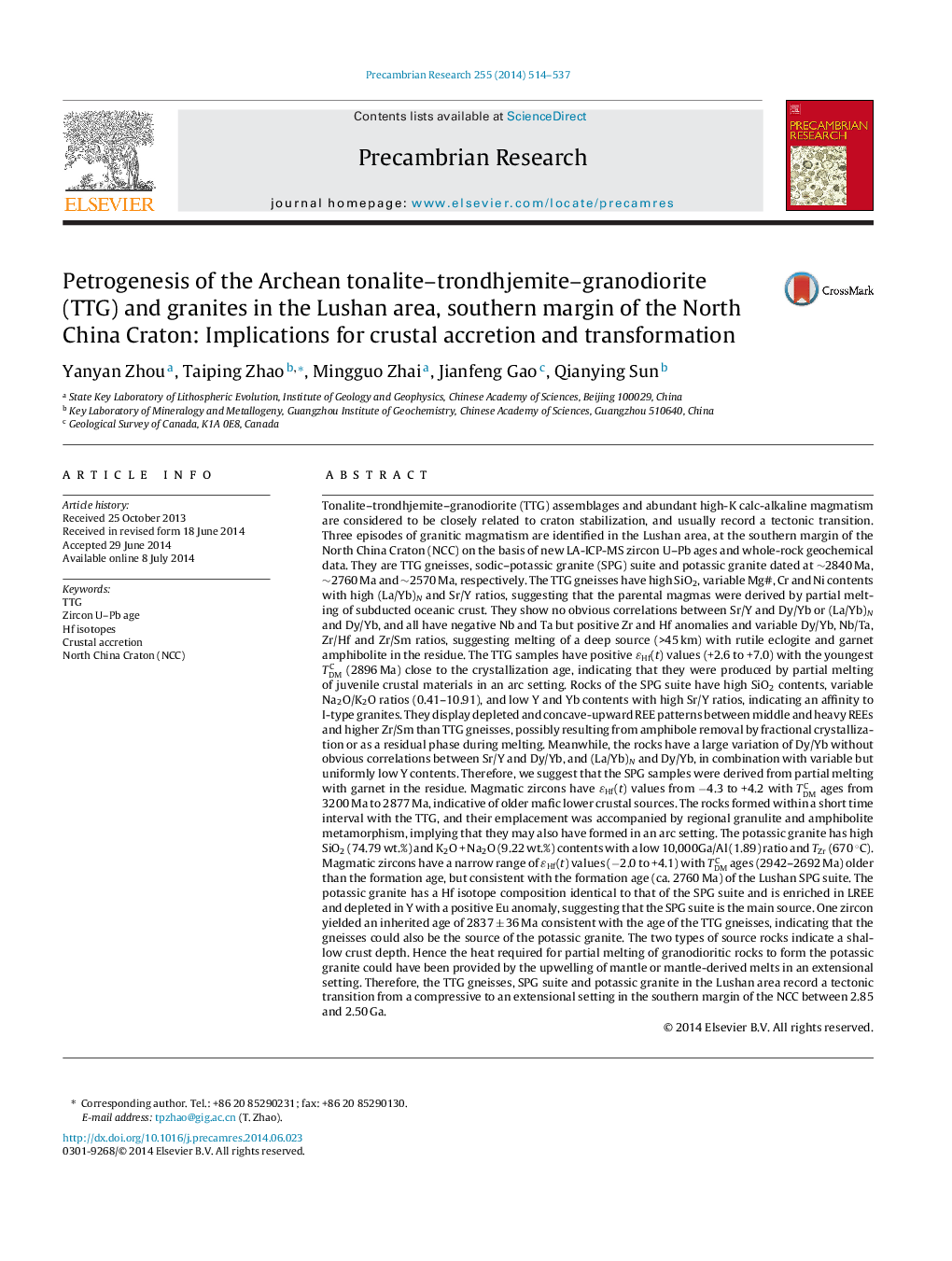| کد مقاله | کد نشریه | سال انتشار | مقاله انگلیسی | نسخه تمام متن |
|---|---|---|---|---|
| 4722751 | 1355487 | 2014 | 24 صفحه PDF | دانلود رایگان |

• TTG and two episodic granitoids formed at ∼2840 Ma, ∼2760 Ma and ∼2570 Ma.
• TTG formed by partial melting of subducted oceanic crust in an arc setting.
• SPG suite derived by partial melting of both juvenile and old lower crust.
• Potassic granite derived from SPG and TTG in extensional setting.
• Three episodic magmatism record tectonic change from compression to extension.
Tonalite–trondhjemite–granodiorite (TTG) assemblages and abundant high-K calc-alkaline magmatism are considered to be closely related to craton stabilization, and usually record a tectonic transition. Three episodes of granitic magmatism are identified in the Lushan area, at the southern margin of the North China Craton (NCC) on the basis of new LA-ICP-MS zircon U–Pb ages and whole-rock geochemical data. They are TTG gneisses, sodic–potassic granite (SPG) suite and potassic granite dated at ∼2840 Ma, ∼2760 Ma and ∼2570 Ma, respectively. The TTG gneisses have high SiO2, variable Mg#, Cr and Ni contents with high (La/Yb)N and Sr/Y ratios, suggesting that the parental magmas were derived by partial melting of subducted oceanic crust. They show no obvious correlations between Sr/Y and Dy/Yb or (La/Yb)N and Dy/Yb, and all have negative Nb and Ta but positive Zr and Hf anomalies and variable Dy/Yb, Nb/Ta, Zr/Hf and Zr/Sm ratios, suggesting melting of a deep source (>45 km) with rutile eclogite and garnet amphibolite in the residue. The TTG samples have positive ɛHf(t ) values (+2.6 to +7.0) with the youngest TDMC (2896 Ma) close to the crystallization age, indicating that they were produced by partial melting of juvenile crustal materials in an arc setting. Rocks of the SPG suite have high SiO2 contents, variable Na2O/K2O ratios (0.41–10.91), and low Y and Yb contents with high Sr/Y ratios, indicating an affinity to I-type granites. They display depleted and concave-upward REE patterns between middle and heavy REEs and higher Zr/Sm than TTG gneisses, possibly resulting from amphibole removal by fractional crystallization or as a residual phase during melting. Meanwhile, the rocks have a large variation of Dy/Yb without obvious correlations between Sr/Y and Dy/Yb, and (La/Yb)N and Dy/Yb, in combination with variable but uniformly low Y contents. Therefore, we suggest that the SPG samples were derived from partial melting with garnet in the residue. Magmatic zircons have ɛHf(t ) values from −4.3 to +4.2 with TDMC ages from 3200 Ma to 2877 Ma, indicative of older mafic lower crustal sources. The rocks formed within a short time interval with the TTG, and their emplacement was accompanied by regional granulite and amphibolite metamorphism, implying that they may also have formed in an arc setting. The potassic granite has high SiO2 (74.79 wt.%) and K2O + Na2O (9.22 wt.%) contents with a low 10,000Ga/Al (1.89) ratio and TZr (670 °C). Magmatic zircons have a narrow range of ɛHf(t ) values (−2.0 to +4.1) with TDMC ages (2942–2692 Ma) older than the formation age, but consistent with the formation age (ca. 2760 Ma) of the Lushan SPG suite. The potassic granite has a Hf isotope composition identical to that of the SPG suite and is enriched in LREE and depleted in Y with a positive Eu anomaly, suggesting that the SPG suite is the main source. One zircon yielded an inherited age of 2837 ± 36 Ma consistent with the age of the TTG gneisses, indicating that the gneisses could also be the source of the potassic granite. The two types of source rocks indicate a shallow crust depth. Hence the heat required for partial melting of granodioritic rocks to form the potassic granite could have been provided by the upwelling of mantle or mantle-derived melts in an extensional setting. Therefore, the TTG gneisses, SPG suite and potassic granite in the Lushan area record a tectonic transition from a compressive to an extensional setting in the southern margin of the NCC between 2.85 and 2.50 Ga.
Journal: Precambrian Research - Volume 255, Part 2, December 2014, Pages 514–537